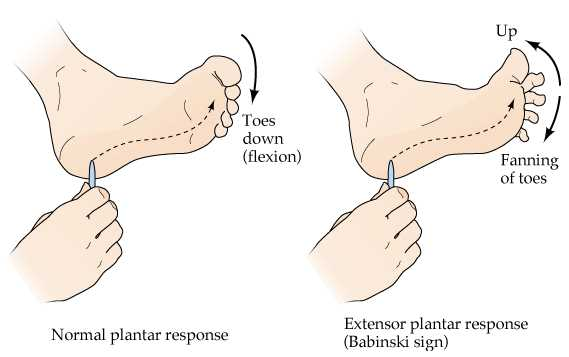A nurse is assessing the reflexes of a client who has an unrepaired femur fracture and has suddenly become stuporous. For which of the following findings should the nurse identify that the client exhibits Babinski's sign?
Dorsiflexion of the great toe
Pronation of the arms
Pinpoint pupils
Jerking contractions of the head and neck
The Correct Answer is A
Choice A reason:
Babinski's sign is a neurological reflex that's tested by stroking the sole of the foot. A positive Babinski's sign, which is normal in infants but abnormal in adults, is indicated by dorsiflexion of the great toe (the toe points up) while the other toes fan out. This reflex suggests dysfunction of the corticospinal tract, which may be due to various neurological conditions. In the context of a stuporous patient with an unrepaired femur fracture, a positive Babinski's sign could indicate an acute neurological change possibly related to the injury or a secondary complication such as a fat embolism syndrome, which can occur after fractures and may affect the brain.
Choice B reason:
Pronation of the arms is not associated with Babinski's sign. Pronation is a rotational movement where the hand and upper arm are turned inwards. While arm movements are part of the neurological examination, they do not constitute a response to the plantar reflex test used to elicit Babinski's sign.
Choice C reason:
Pinpoint pupils may indicate opioid overdose or damage to the pons due to various causes, but they are not a component of Babinski's sign. Pupil size and reaction to light are important in neurological assessments, but they are separate from the reflexes tested by the Babinski sign.
Choice D reason:
Jerking contractions of the head and neck are not related to Babinski's sign. These could be indicative of seizure activity or other neurological disorders but are not a response to the plantar reflex test.

Nursing Test Bank
Naxlex Comprehensive Predictor Exams
Related Questions
Correct Answer is ["A","D","E"]
Explanation
Choice B reason:
Sleeping on a soft mattress is not recommended for preventing low back pain. A medium-firm mattress often provides better support for the spine. A soft mattress may allow the body to sink in too deeply, causing misalignment of the spine during sleep.
Choice C reason:
Applying heat for 10 minutes every hour is not a standard recommendation for preventing low back pain. While heat therapy can help relax muscles and relieve pain, it is typically advised to apply heat for longer periods, such as 15-20 minutes, and not as frequently as every hour.
Choice D reason:
Sleeping in a side-lying position with flexed knees can help maintain the natural curve of the spine and minimize back strain. This position can also reduce pressure on the back and is often recommended for those with low back pain.
Choice E reason:
Trying padded shoe insoles can help minimize back strain by providing additional support and cushioning for the feet, which can improve alignment and reduce the impact on the back during walking or standing.
Correct Answer is C
Explanation
Choice A reason:
Keeping artificial nails trimmed is a recommended practice in healthcare settings to maintain effective hand hygiene. Long nails can harbor bacteria and make it difficult to clean hands thoroughly. However, the CDC does not provide specific guidelines on the length of artificial nails for healthcare workers.
Choice B reason:
When caring for a client with Clostridium difficile, it is recommended to wash hands with soap and water rather than using alcohol-based hand rubs. Alcohol-based hand rubs are not effective against C. difficile spores. Therefore, thorough handwashing with soap and water is necessary to remove spores.
Choice C reason:
Chlorhexidine is an antiseptic agent that provides broad-spectrum antimicrobial activity and is recommended for hand hygiene in certain situations, such as before invasive procedures or for clients who are immunosuppressed. It is effective against a wide range of bacteria, viruses, and fungi, making it a suitable choice for immunocompromised patients to reduce the risk of infection.
Choice D reason:
The use of alcohol-based hand rubs before administering eye drops is not specifically recommended. While hand hygiene is essential before any contact with a patient, there is no particular preference for alcohol-based hand rubs in this context. The primary concern is to ensure that hands are clean to prevent contamination of the eye drops or the patient's eyes.
Whether you are a student looking to ace your exams or a practicing nurse seeking to enhance your expertise , our nursing education contents will empower you with the confidence and competence to make a difference in the lives of patients and become a respected leader in the healthcare field.
Visit Naxlex, invest in your future and unlock endless possibilities with our unparalleled nursing education contents today
Report Wrong Answer on the Current Question
Do you disagree with the answer? If yes, what is your expected answer? Explain.
Kindly be descriptive with the issue you are facing.
